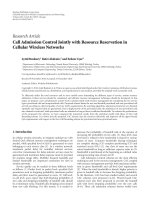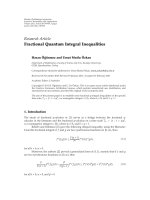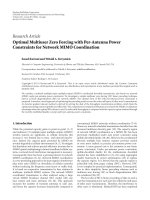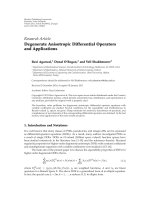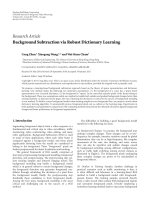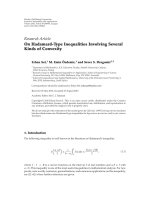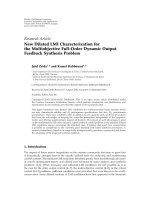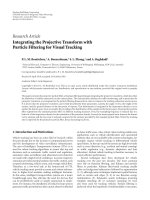Báo cáo hóa học: "Research Article New Retarded Integral Inequalities with Applications" potx
Bạn đang xem bản rút gọn của tài liệu. Xem và tải ngay bản đầy đủ của tài liệu tại đây (530.61 KB, 15 trang )
Hindawi Publishing Corporation
Journal of Inequalities and Applications
Volume 2008, Article ID 908784, 15 pages
doi:10.1155/2008/908784
Research Article
New Retarded Integral Inequalities
with Applications
Ravi P. Agarwal,
1
Young-Ho Kim,
2
andS.K.Sen
1
1
Department of Mathematical Sciences, Florida Institute of Technology, 150 West University Boulevard,
Melbourne, FL 32901, USA
2
Department of Applied Mathematics, College of Natural Sciences Changwon National University
Changwon, Kyeongnam 641-773, South Korea
Correspondence should be addressed to Young-Ho Kim,
Received 29 January 2008; Accepted 24 April 2008
Recommended by Yeol Je Cho
Some new nonlinear integral inequalities of Gronwall type for retarded functions are established,
which extend the results Lipovan 2003 and Pachpatte 2004. These inequalities can be used as
basic tools in the study of certain classes of functional differential equations as well as integral
equations. A existence and a uniqueness on the solution of the functional differential equation
involving several retarded arguments with the initial condition are also indicated.
Copyright q 2008 Ravi P. Agarwal et al. This is an open access article distributed under the Creative
Commons Attribution License, which permits unrestricted use, distribution, and reproduction in
any medium, provided the original work is properly cited.
1. Introduction
The celebrated Gronwall inequality 1 states that if u and f are nonnegative continuous
functions on the interval a, b satisfying
ut ≤ c
t
a
fsusds, t ∈ a, b, 1.1
for some constant c ≥ 0, then
ut ≤ c exp
t
a
fsds
,t∈ a, b. 1.2
Since the inequality 1.2 provides an explicit bound to the unknown function u and
hence furnishes a handy tool in the study of solutions of differential equations. Because of its
2 Journal of Inequalities and Applications
fundamental importance, several generalizations and analogous results of the inequality 1.2
have been established o ver years. Such generalizations are, in general, referred to as Gronwall
type inequalities 2–6. These inequalities provide necessary tools in the study of the theory
of differential equations, integral equations, and inequalities of various types. Many authors
2–21 have established several other very useful Gronwall-like integral inequalities. Among
these inequalities, the following one Theorem A due to Ou-Yang 15 needs specific mention.
It is useful in the study of boundedness of certain second-order differential equations.
Theorem A Ou-Yang 15. If u and f are nonnegative continuous functions on 0, ∞ such that
u
2
t ≤ u
2
0
2
t
0
fsusds 1.3
for all t ∈ 0, ∞, where u
0
≥ 0 is a constant, then
ut ≤ u
0
t
0
fsds, t ∈ 0, ∞. 1.4
The Ou-Yang inequality prompted researchers to devote considerable time for its
generalization and consequent applications 3, 4, 9, 11, 14. For instance, Lipovan established
the following generalization Theorem B of Ou-Yang’s inequality in the process of establishing
a connection between stability and the second law of thermodynamics 14.
Theorem B Lipovan 14. Let u, f, and g be continuous nonnegative functions on R
and c be a
nonnegative constant. Also, let w ∈ CR
,R
be a nondecreasing function with wu > 0 on 0, ∞
and α ∈ C
1
R
,R
be nondecreasing with αt ≤ t on R
. If
u
2
t ≤ c
2
2
αt
0
fsusw
us
gsus
ds 1.5
for all t ∈ R
, then for 0 ≤ t ≤ t
1
,
ut ≤ Ω
−1
Ω
c
αt
0
gsds
αt
0
fsds
,
Ωr
r
1
ds
ws
,r>0,
1.6
Ω
−1
is the inverse function of Ω, and t
1
∈ R
is chosen so that Ωc
αt
0
gsds
αt
0
fsds ∈
DomΩ
−1
for all t ∈ R
lying in the interval 0 ≤ t ≤ t
1
.
More recently, Pachpatte established further generalization Theorem C of Theorem B as
follows 20, which is handy in the study of the global existence of solutions to certain integral
equations and functional differential equations.
Theorem C Pachpatte 20. Let u, a
i
,b
i
∈ CI, R
and let α
i
∈ C
1
I,I be nondecreasing with
α
i
t ≤ t on I for i 1, ,n.Let p>1 and c ≥ 0 be constants and w ∈ CR
,R
be nondecreasing
with wu > 0 on 0, ∞. If for t ∈ I,
u
p
t ≤ c p
n
i1
α
i
t
α
i
t
0
us
a
i
sψ
us
b
i
s
ds, 1.7
Ravi P. Agarwal et al. 3
then for t
0
≤ t ≤ t
1
,
ut ≤
G
−1
GAt
p − 1
n
i1
α
i
t
α
i
t
0
a
i
σdσ
1/p−1
, 1.8
where
Gr
r
r
0
ds
w
s
1/p−1
,r≥ r
0
> 0,
Atc
p−1/p
p − 1
n
i1
α
i
t
α
i
t
0
b
i
σdσ,
1.9
r
0
> 0 is arbitrary, G
−1
is the inverse function of G and t
1
∈ I is so chosen that
GAt p − 1
n
i1
α
i
t
α
i
t
0
a
i
σdσ ∈ Dom
G
−1
. 1.10
The present paper establishes some nonlinear retarded inequalities which extend the
foregoing theorems. In addition, it illustrates the use/application of these inequalities.
2. Main results
Let R denote the set of real numbers, R
0, ∞ and R
1
1, ∞. Also, let I t
0
,T be
the given subset of R. Denote by C
i
M, N the class of all i-times continuously differentiable
functions defined on the set M to the set N for i 1, 2, and C
0
M, NCM, N.
Theorem 2.1. Let u, f
i
,g
i
∈ CI,R
,i 1, ,n, and let α
i
∈ C
1
I,I be nondecreasing with
α
i
t ≤ t, i 1, ,n. Suppose that c ≥ 0 and q>0 are constants, ϕ ∈ C
1
R
,R
is an increasing
function with ϕ∞∞ on I, and ψu is a nondecreasing continuous function for u ∈ R
with
ψu > 0 for u>0. If
ϕ
ut
≤ c
n
i1
α
i
t
α
i
t
0
u
q
s
f
i
sψ
us
g
i
s
ds 2.1
for t ∈ I, then
ut ≤ ϕ
−1
G
−1
Ψ
−1
Ψ
k
t
0
n
i1
α
i
t
α
i
t
0
f
i
sds
2.2
for t ∈ t
0
,t
1
, where
Gr
r
r
0
ds
ϕ
−1
s
q
,r≥ r
0
> 0,
Ψr
r
r
0
ds
ψϕ
−1
G
−1
s
,r≥ r
0
> 0,
k
t
0
Gc
n
i1
α
i
t
α
i
t
0
g
i
sds,
2.3
4 Journal of Inequalities and Applications
G
−1
and Ψ
−1
denote the inverse functions of G and Ψ, respectively, for t ∈ I.t
1
∈ I is so chosen
that
Ψ
k
t
0
n
i1
α
i
t
α
i
t
0
f
i
sds ∈ Dom
Ψ
−1
. 2.4
Proof. Assume that c>0. Define a function zt by the right-hand side of 2.1. Clearly, zt is
nondecreasing, ut ≤ ϕ
−1
zt for t ∈ I and zt
0
c. Differentiating zt we get
z
t
n
i1
u
α
i
t
q
f
i
α
i
t
ψ
u
α
i
t
g
i
α
i
t
α
i
t
≤
ϕ
−1
zt
q
n
i1
f
i
α
i
t
ψ
ϕ
−1
z
α
i
t
g
i
α
i
t
α
i
t.
2.5
Using the monotonicity of ϕ
−1
and z, we deduce
ϕ
−1
zt
q
≥
ϕ
−1
zt
0
q
ϕ
−1
c
q
> 0. 2.6
That is
z
t
ϕ
−1
zt
q
≤
n
i1
f
i
α
i
t
ψ
ϕ
−1
z
α
i
t
g
i
α
i
t
α
i
t. 2.7
Setting t s in the inequality 2.7, integrating it from t
0
to t, using the function G in the
left-hand side, and changing variable in the right-hand side, we obtain
G
zt
≤ Gc
n
i1
α
i
t
α
i
t
0
f
i
sψ
ϕ
−1
zs
g
i
s
ds. 2.8
From the inequality 2.8, we find
G
zt
≤ pt
n
i1
α
i
t
α
i
t
0
f
i
sψ
ϕ
−1
zs
ds, 2.9
where
ptGc
n
i1
α
i
t
α
i
t
0
g
i
sds. 2.10
From the inequality 2.9, we observe that
G
zt
≤ p
t
1
n
i1
α
i
t
α
i
t
0
f
i
sψ
ϕ
−1
zs
ds, 2.11
for t ≤ t
1
. Now, define a function kt by the right-hand side of 2.11. Clearly, kt is
nondecreasing, zt ≤ G
−1
kt for t ∈ I and kt
0
pt
1
. Differentiating kt,weget
k
t
n
i1
f
i
α
i
t
ψ
ϕ
−1
z
α
i
t
α
i
t ≤ ψ
ϕ
−1
G
−1
kt
n
i1
f
i
α
i
t
α
i
t. 2.12
Ravi P. Agarwal et al. 5
Using the monotonicity of ψ, ϕ
−1
,G
−1
,andk, we deduce
k
t
ψ
ϕ
−1
G
−1
kt
≤
n
i1
f
i
α
i
t
α
i
t. 2.13
Setting t s in the inequality 2.13, integrating it from t
0
to t, using the function Ψ in the
left-hand side, and changing variable in the right-hand side, we obtain
Ψ
kt
≤ Ψ
k
t
0
n
i1
α
i
t
α
i
t
0
f
i
sds. 2.14
From the inequalities 2.11 and 2.14, we conclude that
zt ≤ G
−1
Ψ
−1
Ψ
pt
1
n
i1
α
i
t
α
i
t
0
f
i
sds
2.15
for t
0
≤ t ≤ t
1
. Now a combination of ut ≤ ϕ
−1
zt and the last inequality in 2.15 for t
1
t
produces the required inequality.
If c 0 we carry out the above procedure with ε>0 instead of c and subsequently let
ε→0. This completes the proof.
For the special case ϕuu
p
p>q>0 is a constant, Theorem 2.1 gives the following
retarded integral inequality for nonlinear functions.
Corollary 2.2. Let u, f
i
,g
i
∈ CI,R
,i 1, ,n, and let α
i
∈ C
1
I,I be nondecreasing with
α
i
t ≤ t, i 1, ,n. Suppose that c ≥ 0 and p>q>0 are constants, and ψu is a nondecreasing
continuous function for u ∈ R
with ψu > 0 for u>0. If
u
p
t ≤ c
n
i1
α
i
t
α
i
t
0
u
q
s
f
i
sψ
us
g
i
s
ds 2.16
for t ∈ I, then
ut ≤
Ψ
−1
0
Ψ
0
k
1
t
0
p − q
p
n
i1
α
i
t
α
i
t
0
f
i
sds
1/p−q
2.17
for t ∈ t
0
, t, where
Ψ
0
r
r
r
0
ds
ψ
s
1/p−q
,r≥ r
0
> 0,
k
1
t
0
c
p−q/p
p − q
p
n
i1
α
i
t
α
i
t
0
g
i
sds,
2.18
Ψ
−1
0
denotes the inverse function of Ψ
0
for t ∈ I. t ∈ I is so chosen that
Ψ
0
k
1
t
0
p − q
p
n
i1
α
i
t
α
i
t
0
f
i
sds ∈ Dom
Ψ
−1
0
. 2.19
6 Journal of Inequalities and Applications
Proof. The proof follows by an argument similar to that in the proof of Theorem 2.1 with
suitable modification. We omit the details here.
Remark 2.3. When q 1, from Corollary 2.2, one derives Theorem C. When p 2,q 1, from
Corollary 2.2, one derives Theorem B.
Theorem 2.1 can easily be applied to generate other useful nonlinear integral inequalities
in more general situations. For example, one has the following result Theorem 2.4.
Theorem 2.4. Let u ∈ CI, R
1
,f
i
,g
i
∈ CI, R
,i 1, ,n, and let α
i
∈ C
1
I,I be nondecreasing
with α
i
t ≤ t, i 1, ,n.Suppose that c ≥ 1 is a constant, ϕ ∈ C
1
R
,R
is an increasing function
with ϕ∞∞ and ψ
j
u,j 1, 2 are nondecreasing continuous functions for u ∈ R
with ψ
j
u > 0
for u>0. If
ϕ
ut
≤ c
n
i1
α
i
t
α
i
t
0
u
q
s
f
i
sψ
1
us
g
i
sψ
2
log
us
ds 2.20
for t ∈ I, then
i as the case ψ
1
u ≥ ψ
2
logu,
ut ≤ ϕ
−1
G
−1
Ψ
−1
1
Ψ
1
Gc
n
i1
α
i
t
α
i
t
0
f
i
sg
i
s
ds
2.21
for t ∈ t
0
,t
1
,
ii as the case ψ
1
u <ψ
2
logu,
ut ≤ ϕ
−1
G
−1
Ψ
−1
2
Ψ
2
Gc
n
i1
α
i
t
α
i
t
0
f
i
sg
i
s
ds
2.22
for t ∈ t
0
,t
2
, where
Ψ
j
r
r
r
0
ds
ψ
j
ϕ
−1
G
−1
s
,r≥ r
0
> 0, 2.23
G
−1
, Ψ
−1
j
,j 1, 2, denote the inverse functions of G, Ψ
j
,j 1, 2, respectively, the function
Gt is as defined in Theorem 2.1 for t ∈ I, and t
j
∈ I, j 1, 2 are so chosen that
Ψ
j
Gc
n
i1
α
i
t
α
i
t
0
f
i
sg
i
s
ds ∈ Dom
Ψ
−1
j
. 2.24
Proof. Let c>0. Define a function zt by the right-hand side of 2.20. Clearly, zt is
nondecreasing, ut ≤ ϕ
−1
zt for t ∈ I and zt
0
c. Differentiating zt,weget
z
t
n
i1
u
α
i
t
q
f
i
α
i
t
ψ
1
u
α
i
t
g
i
α
i
t
ψ
2
log
u
α
i
t
α
i
t
≤
ϕ
−1
zt
q
n
i1
f
i
α
i
t
ψ
1
ϕ
−1
z
α
i
t
g
i
α
i
t
ψ
2
log
ϕ
−1
z
α
i
t
α
i
t.
2.25
Ravi P. Agarwal et al. 7
Using the monotonicity of ϕ
−1
and z, we deduce
ϕ
−1
zt
q
≥
ϕ
−1
z
t
0
q
ϕ
−1
c
q
> 0. 2.26
That is
z
t
ϕ
−1
zt
q
≤
n
i1
f
i
α
i
tψ
1
ϕ
−1
zα
i
t g
i
α
i
tψ
2
logϕ
−1
zα
i
tα
i
t. 2.27
Setting t s in the inequality 2.27, integrating it from t
0
to t, using the function G in the
left-hand side, and changing variable in the right-hand side, we obtain
G
zt
≤ Gc
n
i1
α
i
t
α
i
t
0
f
i
sψ
1
ϕ
−1
zs
g
i
sψ
2
log
ϕ
−1
zs
ds. 2.28
When ψ
1
u ≥ ψ
2
logu, from the inequality 2.28, we find
G
zt
≤ Gc
n
i1
α
i
t
α
i
t
0
f
i
sg
i
s
ψ
1
ϕ
−1
zs
ds. 2.29
Now, define a function kt by the right-hand side of 2.29. Clearly, kt is nondecreasing,
zt ≤ G
−1
kt for t ∈ I and kt
0
Gc. Differentiating kt,weget
k
t
n
i1
f
i
α
i
t
g
i
α
i
t
ψ
1
ϕ
−1
z
α
i
t
α
i
t
≤ ψ
1
ϕ
−1
G
−1
kt
n
i1
f
i
α
i
t
g
i
α
i
t
α
i
t.
2.30
Using the monotonicity of ψ
1
,ϕ
−1
,G
−1
,andk, we deduce
k
t
ψ
1
ϕ
−1
G
−1
kt
≤
n
i1
f
i
α
i
t
α
i
t. 2.31
Setting t s in the inequality 2.31, integrating it from t
0
to t, using the function Ψ
1
in the
left-hand side, and changing variable in the right-hand side, we obtain
Ψ
1
kt
≤ Ψ
1
k
t
0
n
i1
α
i
t
α
i
t
0
f
i
sg
i
s
ds. 2.32
From the inequality 2.32, we conclude that
zt ≤ G
−1
Ψ
−1
1
Ψ
1
Gc
n
i1
α
i
t
α
i
t
0
f
i
sg
i
s
ds
2.33
for t ∈ I. Now a combination of ut ≤ ϕ
−1
zt and the last inequality produces the required
inequality in 2.21.
8 Journal of Inequalities and Applications
When ψ
1
u <ψ
1
logu, from the inequality 2.28, we find
G
zt
≤ Gc
n
i1
α
i
t
α
i
t
0
f
i
sg
i
s
ψ
1
ϕ
−1
zs
ds. 2.34
Now, by a suitable application of the process from 2.29 to 2.32 in the inequality 2.34,we
conclude that
zt ≤ G
−1
Ψ
−1
2
Ψ
2
Gc
n
i1
α
i
t
α
i
t
0
f
i
sg
i
s
ds
2.35
for t ∈ I. Now a combination of ut ≤ ϕ
−1
zt and the last inequality produces the required
inequality in 2.22.
If c 0, we carry out the above procedure with ε>0 instead of c and subsequently let
ε→0. This completes the proof.
For the special case ϕuu
p
p>q>0 is a constant, Theorem 2.4 gives the following
retarded integral inequality for nonlinear functions.
Corollary 2.5. Let u ∈ CI, R
1
,f
i
,g
i
∈ CI, R
,i 1, ,n, and let α
i
∈ C
1
I,I be nondecreasing
with α
i
t ≤ t, i 1, ,n. Suppose that c ≥ 0 and p>q>0 are constants, and ψ
j
u,j 1, 2 are
nondecreasing continuous functions for u ∈ R
with ψ
j
u > 0 for u>0. If
u
p
t ≤ c
n
i1
α
i
t
α
i
t
0
u
q
s
f
i
sψ
1
us
g
i
sψ
2
log us
ds 2.36
for t ∈ I, then
i as the case ψ
1
u ≥ ψ
2
logu,
ut ≤
G
−1
1
G
1
c
p−q/p
p − q
p
n
i1
α
i
t
α
i
t
0
f
i
sg
i
s
ds
1/p−q
2.37
for t ∈ t
0
,t
1
,
ii as the case ψ
1
u <ψ
2
logu,
ut ≤
G
−1
2
G
2
c
p−q/p
p − q
p
n
i1
α
i
t
α
i
t
0
f
i
sg
i
s
ds
1/p−q
2.38
for t ∈ t
0
,t
2
, where G
−1
j
,j 1, 2, denote the inverse functions of G
j
,j 1, 2,
G
j
r
r
r
0
ds
ψ
j
s
1/p−q
,r≥ r
0
> 0, 2.39
for t ∈ I, and t
j
∈ I, j 1, 2, are chosen so that
G
j
c
p−q/p
p − q
p
n
i1
α
i
t
α
i
t
0
f
i
sg
i
s
ds ∈ DomG
−1
j
. 2.40
Ravi P. Agarwal et al. 9
Proof. The proof follows by an argument similar to that in the proof of Theorem 2.4 with
suitable modification. We omit the details here.
Theorem 2.1 can easily be applied to generate another useful nonlinear integral inequal-
ities in more general situations. For example, we have the following result Theorem 2.6.
Theorem 2.6. Let u, f
i
,g
i
∈ CI, R
,i 1, ,n, and let α
i
∈ C
1
I,I be nondecreasing with
α
i
t ≤ t, i 1, ,n. Suppose that c ≥ 0 and q>0 are constants, ϕ ∈ C
1
R
,R
is an increasing
function with ϕ∞∞ on I, and L, M ∈ CR
2
,R
satisfy
0 ≤ Lt, v − Lt, w ≤ Mt, wv − w2.41
for t, v, w ∈ R
with v ≥ w ≥ 0. If
ϕ
ut
≤ c
n
i1
α
i
t
α
i
t
0
u
q
s
f
i
sL
s, us
g
i
sus
ds 2.42
for t ∈ I, then
ut ≤ ϕ
−1
G
−1
Ω
−1
Ω
k
2
t
0
n
i1
α
i
t
α
i
t
0
f
i
sMsg
i
s
ds
2.43
for t ∈ t
0
,t
1
, where
Ωr
r
r
0
ds
ϕ
−1
G
−1
s
,r≥ r
0
> 0,
k
2
t
0
Gc
n
i1
α
i
t
α
i
t
0
f
i
sLsds,
2.44
G
−1
and Ω
−1
denote the inverse function of G and Ω, respectively, the function G is as defined in
Theorem 2.1 for t ∈ I and t
1
∈ I is so chosen that
Ω
k
2
t
0
n
i1
α
i
t
α
i
t
0
f
i
sds ∈ Dom
Ω
−1
. 2.45
Proof. Let c>0. Define a function zt by the right-hand side of 2.42. Clearly, zt is
nondecreasing, ut ≤ ϕ
−1
zt for t ∈ I and zt
0
c. Differentiating zt,weget
z
t
n
i1
u
α
i
t
q
f
i
α
i
t
L
α
i
t,u
α
i
t
g
i
α
i
t
u
α
i
t
α
i
t
≤
ϕ
−1
zt
q
n
i1
f
i
α
i
t
L
α
i
t,ϕ
−1
z
α
i
t
g
i
α
i
t
ϕ
−1
z
α
i
t
α
i
t.
2.46
Using the monotonicity of ϕ
−1
and z, we deduce
z
t
ϕ
−1
zt
q
≤
n
i1
f
i
α
i
t
L
α
i
t,ϕ
−1
z
α
i
t
g
i
α
i
t
ϕ
−1
z
α
i
t
α
i
t. 2.47
10 Journal of Inequalities and Applications
Setting t s in the inequality 2.47, integrating it from t
0
to t, using the function G in the
left-hand side, and changing variable in the right-hand side, we obtain
G
zt
≤ Gc
n
i1
α
i
t
α
i
t
0
f
i
sL
s, ϕ
−1
zs
g
i
sϕ
−1
zs
ds. 2.48
From the inequalities 2.41, 2.48, we find
G
zt
≤ Gc
n
i1
α
i
t
1
α
i
t
0
f
i
sL s ds
n
i1
α
i
t
α
i
t
0
f
i
sMsg
i
s
ϕ
−1
zs
ds,
2.49
for t ≤ t
1
. Now, define a function k
2
t by the right-hand side of 2.49. Clearly, k
2
t is
nondecreasing, zt ≤ G
−1
k
2
t for t ∈ I. Differentiating k
2
t,weget
k
2
t
n
i1
f
i
α
i
tMα
i
t g
i
α
i
tϕ
−1
zsα
i
t
≤ ϕ
−1
G
−1
k
2
t
n
i1
f
i
α
i
tMα
i
t g
i
α
i
tα
i
t.
2.50
Using the monotonicity of ϕ
−1
,G
−1
,andk
2
, we deduce
k
2
t
ψ
ϕ
−1
G
−1
k
2
t
≤
n
i1
f
i
α
i
t
M
α
i
t
g
i
α
i
t
α
i
t. 2.51
Setting t s in the inequality 2.51, integrating it from t
0
to t, using the function Ω in the
left-hand side, and changing variable in the right-hand side, we obtain
Ω
k
2
t
≤ Ω
k
2
t
0
n
i1
α
i
t
α
i
t
0
f
i
sMsg
i
s
ds. 2.52
From the inequalities 2.49 and 2.52, we conclude that
zt ≤ G
−1
Ω
−1
Ω
k
2
t
0
n
i1
α
i
t
α
i
t
0
f
i
sMsg
i
s
ds
2.53
for t
0
≤ t ≤ t
1
. Now a combination of ut ≤ ϕ
−1
zt and the last inequality produces the
required inequality in 2.43 for t
1
t.
If c 0, we carry out the above procedure with ε>0 instead of c and subsequently let
ε→0. This completes the proof.
For the special case ϕuu
p
p>q>0 is a constant, Theorem 2.6 gives the following
retarded integral inequality for nonlinear functions.
Corollary 2.7. Let u, f
i
,g
i
, and α
i
be as defined in Theorem 2.6. Suppose that c ≥ 0 and p>q>0 are
constants, and L, M ∈ CR
2
,R
satisfy
0 ≤ Lt, v − Lt, w ≤ Mt, wv − w2.54
Ravi P. Agarwal et al. 11
for t, v, w ∈ R
with v ≥ w ≥ 0. If
u
p
t ≤ c
n
i1
α
i
t
α
i
t
0
u
q
s
f
i
sL
s, us
g
i
sus
ds 2.55
for t ∈ I, then
ut ≤
Ω
−1
1
Ω
1
k
3
t
0
p − q
p
n
i1
α
i
t
α
i
t
0
f
i
sMsg
i
s
ds
1/p−q
2.56
for t ∈ t
0
,t
1
, where
Ω
1
r
r
r
0
ds
s
1/p−q
,r≥ r
0
> 0,
k
3
t
0
c
p−q/p
p − q
p
n
i1
α
i
t
α
i
t
0
f
i
sLsds,
2.57
Ω
−1
1
denotes the inverse function of Ω
1
for t ∈ I and t
1
∈ I is so chosen that
Ω
1
k
3
t
0
p − q
p
n
i1
α
i
t
α
i
t
0
f
i
sMsg
i
s
ds ∈ Dom
Ω
−1
1
. 2.58
Proof. The proof follows by an argument similar to that in the proof of Theorem 2.6 with
suitable modification. We omit the details here.
3. Applications
We will show that our results are useful in proving the global existence of solutions to certain
differential equations with time delay. Consider the functional differential equation involving
several retarded arguments with the initial condition:
ϕ
xt
x
tF
t, x
t − h
1
t
, ,x
t − h
n
t
,t∈ I,
x
t
0
x
0
,
3.1
where x
0
is a constant, F ∈ CI × R
n
,R,h
i
∈ CI, R
,i 1, ,nbe nonincreasing such that
t − h
i
t ≥ 0,t− h
i
t ∈ C
1
I,I,h
i
t < 1, and ϕ ∈ C
1
R, R is an increasing function with
ϕ|x| ≤|ϕx|. The following theorem deals with a bound on the solution of the problem 3.1.
Theorem 3.1. Assume that F : I × R
n
→R is a continuous function for which there exist continuous
nonnegative functions f
i
t,g
i
t,i 1, ,nfor t ∈ I such that
F
t, u
1
, ,u
n
≤
n
i1
u
i
q
f
i
tψ
u
i
g
i
t
, 3.2
12 Journal of Inequalities and Applications
where q>0 is a constant and ψ is as in Theorem 2.1.Let
Q
i
max
t∈I
1
1 − h
i
t
,i 1, ,n. 3.3
If xt is any solution of the problem 3.1,then
xt
≤ ϕ
−1
G
−1
Ψ
−1
Ψ
k
t
0
n
i1
t−h
i
t
t
0
−h
i
t
0
f
i
σdσ
3.4
for t ∈ I, where G, Ψ are as in Theorem 2.1 and
k
t
0
G
ϕ
x
0
n
i1
t−h
i
t
t
0
−h
i
t
0
g
i
σdσ, 3.5
f
i
σQ
i
f
i
σ h
i
s, g
i
σQ
i
g
i
σ h
i
s for s, σ ∈ I.
Proof. It is easy to see that the solution xt of the problem 3.1 satisfies the equivalent integral
equation:
ϕ
xt
ϕ
x
t
0
t
t
0
F
s, x
s − h
1
s
, ,x
s − h
n
s
ds. 3.6
From 3.2 and 3.6,wehave
ϕ
xt
≤
ϕ
x
t
0
t
t
0
F
s, x
s − h
1
s
, ,x
s − h
n
s
ds
≤
ϕ
x
0
t
t
0
n
i1
x
s − h
i
s
q
f
i
tψ
x
s − h
i
s
g
i
t
ds
3.7
for t, s ∈ I. By making the change of variables on the right side of the inequality of 3.7 and
rewriting, we have
ϕ
xt
≤
ϕ
x
0
n
i1
t−h
i
t
t
0
−h
i
t
0
xσ
q
f
i
σψ
xσ
g
i
σ
dσ, 3.8
where
f
i
σQ
i
f
i
σh
i
s, g
i
σQ
i
g
i
σh
i
s for s, σ ∈ I. Now an immediate application
of the inequality established in Theorem 2.1 to the inequality 3.8 yields the result.
Ravi P. Agarwal et al. 13
Remark 3.2. Consider the functional differential equation involving several retarded arguments
with the initial condition:
px
p−1
tx
tF
t, x
t − h
1
t
, ,x
t − h
n
t
,t∈ I,
x
t
0
x
0
,
3.9
where p>0andx
0
are constants, F ∈ CI × R
n
,R,h
i
∈ CI,R
,i 1, ,nbe nonincreasing
such that t − h
i
t ≥ 0,t− h
i
t ∈ C
1
I,I,h
i
t < 1.
Assume that F : I × R
n
→R is a continuous function for which there exist continuous
nonnegative functions f
i
t,g
i
t,i 1, ,nfor t ∈ I such that
F
t, u
1
, ,u
n
≤
n
i1
u
i
q
f
i
tψ
u
i
g
i
t
, 3.10
where q>0 p>q is a constant and ψ is as in Theorem 2.1.Ifxt is any solution of the
problem 3.9, then it satisfies the equivalent integral equation:
x
p
tx
p
t
0
t
t
0
F
s, x
s − h
1
s
, ,x
s − h
n
s
ds. 3.11
From 3.10 and 3.11, one has
xt
p
≤
x
0
p
t
t
0
F
s, x
s − h
1
s
, ,x
s − h
n
s
ds
≤
x
0
p
t
t
0
n
i1
x
s − h
i
s
q
f
i
tψ
x
s − h
i
s
g
i
t
ds
3.12
for t, s ∈ I. By making the change of variables on the right side of 3.12 and rewriting, one has
xt
p
≤
x
0
p
n
i1
t−h
i
t
t
0
−h
i
t
0
xσ
q
f
i
σψ
xσ
g
i
σ
dσ, 3.13
where
f
i
σQ
i
f
i
σh
i
s, g
i
σQ
i
g
i
σh
i
s for s, σ ∈ I. Now an immediate application
of the inequality established in Corollary 2.2 to the inequality 3.13 yields
xt
≤
Ψ
−1
0
Ψ
0
k
1
t
0
p − q
p
n
i1
t−h
i
t
t
0
−h
i
t
0
f
i
σdσ
1/p−q
3.14
for t ∈ I, where Ψ
0
is as in Corollary 2.2,
k
1
t
0
x
p−q
0
p − q
p
n
i1
t−h
i
t
t
0
−h
i
t
0
g
i
σdσ, 3.15
f
i
σQ
i
f
i
σ h
i
s, and g
i
σQ
i
g
i
σ h
i
s for s, σ ∈ I.
14 Journal of Inequalities and Applications
The following theorem provides a uniqueness on the solution of the problem 3.9.
Theorem 3.3. Assume that F : I × R
3
→R is a continuous function for which there exist continuous
nonnegative functions f
i
t,i 1, ,nfor t ∈ I such that
F
t, u
1
, ,u
n
− F
t, v
1
, ,v
n
≤
n
i1
f
i
t
u
p
i
− v
p
i
, 3.16
where p>1 is a constant, then the problem 3.9 has at most one solution on I.
Proof. Let xt and
xt be two distinct solutions of the problem 3.9, one has
x
p
t − x
p
t
t
t
0
F
s, x
s−h
1
s
, ,x
s − h
n
s
−F
s, x
s − h
1
s
, ,x
s−h
n
s
ds.
3.17
From 3.16 and 3.17, one finds
x
p
t − x
p
t
≤
t
t
0
n
i1
f
i
s
x
p
s − h
i
s
− x
p
s − h
i
s
ds 3.18
for t, s ∈ I. By making the change of variables on the right side of 3.18 and rewriting, one has
x
p
t − x
p
t
1/p
p
≤
n
i1
β
i
t
β
i
t
0
x
p
σ − x
p
σ
1/p
p−1
f
i
σ
x
p
σ − x
p
σ
1/p
dσ, 3.19
where β
i
tt − h
i
t, f
i
σQ
i
f
i
σ h
i
s for s, σ ∈ I. Now when ψuu, q p − 1, a
suitable application of the inequality in Corollary 2.2 to the function |x
p
t − x
p
t|
1/p
and the
inequality 3.19, one concludes that
x
p
t − x
p
t
1/p
≤ 0 3.20
for all t ∈ I. Hence xt
xt.
References
1 T. H. Gronwall, “Note on the derivatives with respect to a parameter of the solutions of a system of
differential equations,” Annals of Mathematics, vol. 20, no. 4, pp. 292–296, 1919.
2 R. P. Agarwal, S. Deng, and W. Zhag, “Generalization of a retarded Gronwall-like inequality and its
applications,” Applied Mathematics and Computation, vol. 165, no. 3, pp. 599–612, 2005.
3 D. Ba
˘
ınov and P. Simeonov, Integral Inequalities and Applications,vol.57ofMathematics and Its
Applications, Kluwer Academic Publishers, Dordrecht, The Netherlands, 1992.
4 W S. Cheung and Q H. Ma, “On certain new Gronwall-Ou-Iang type integral inequalities in two
variables and their applications,” Journal of Inequalities and Applications, vol. 2005, no. 4, pp. 347–361,
2005.
5 N. -E. Tatar, “An impulsive nonlinear singular version of the Gronwall-Bihari inequality,” Journal of
Inequalities and Applications, vol. 2006, Article ID 84561, 12 pages, 2006.
6 H. Ye, J. Gao, and Y. Ding, “A generalized Gronwall inequality and its application to a fractional
differential equation,” Journal of Mathematical Analysis and Applications, vol. 328, no. 2, pp. 1075–1081,
2007.
Ravi P. Agarwal et al. 15
7 R. Bellman, “The stability of solutions of linear differential equations,” Duke Mathematical Journal,vol.
10, pp. 643–647, 1943.
8 I. Bihari, “A generalization of a lemma of Bellman and its application to uniqueness problems of
differential equations,” Acta Mathematica Academiae Scientiarum Hungaricae, vol. 7, no. 1, pp. 81–94,
1956.
9 W S. Cheung, “Some new nonlinear inequalities and applications to boundary value problems,”
Nonlinear Analysis: Theory, Methods & Applications, vol. 64, no. 9, pp. 2112–2128, 2006.
10 Y. J. Cho, S. S. Dragomir, and Y. -H. Kim, “On some integral inequalities with iterated integrals,”
Journal of the Korean Mathematical Society, vol. 43, no. 3, pp. 563–578, 2006.
11 C. M. Dafermos, “The second law of thermodynamics and stability,” Archive for Rational Mechanics and
Analysis, vol. 70, no. 2, pp. 167–179, 1979.
12 S. S. Dragomir and Y H. Kim, “On certain new integral inequalities and their applications,” Journal of
Inequalities in Pure and Applied Mathematics, vol. 3, no. 4, article 65, 8 pages, 2002.
13 S. S. Dragomir a nd Y. -H. Kim, “Some integral inequalities for function of two variables,” Electronic
Journal of Differential Equations, no. 10, pp. 1–13, 2003.
14 O. Lipovan, “A retarded integral inequality and its applications,” Journal of Mathematical Analysis and
Applications, vol. 285, no. 2, pp. 436–443, 2003.
15 L. Ou-Yang, “The boundedness of solutions of linear differential equations y
Aty 0,” Advances
in Mathematics, vol. 3, pp. 409–415, 1957 Chinese.
16 B. G. Pachpatte, “Explicit bounds on certain integral inequalities,” Journal of Mathematical Analysis and
Applications, vol. 267, no. 1, pp. 48–61, 2002.
17 B. G. Pachpatte, “On some retarded integral inequalities and applications,” Journal of Inequalities in
Pure and Applied Mathematics, vol. 3, no. 2, article 18, 7 pages, 2002.
18 B. G. Pachpatte, “On a certain retarded integral inequality and applications,” Journal of Inequalities in
Pure and Applied Mathematics, vol. 5, no. 1, article 19, 9 pages, 2004.
19 B. G. Pachpatte, “Inequalities applicable to certain partial differential equations,” Journal of Inequalities
in Pure and Applied Mathematics, vol. 5, no. 2, article 27, 12 pages, 2004.
20 B. G. Pachpatte, “On some new nonlinear retarded integral inequalities,” Journal of Inequalities in Pure
and Applied Mathematics, vol. 5, no. 3, article 80, 8 pages, 2004.
21 X. Zhao and F. Meng, “On some advanced integral inequalities and their applications,” Journal of
Inequalities in Pure and Applied Mathematics, vol. 6, no. 3, article 60, 8 pages, 2005.
